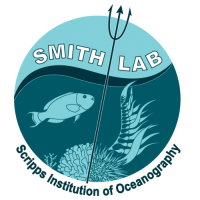It is another beautiful day in paradise. This paradise is sunny San Diego, California. Today we’ll suit up for a dive underneath the pier at Scripps Institution of Oceanography to visit our underwater instruments for a cleaning and calibration water sample. I have done this dive over 200 times, but thankfully it doesn’t get old. I have been able to watch the natural ebb and flow of the marine plants and animals that live and grow on the approximately 50 pier pilings that encompass the Scripps pier. It is a dynamic, high energy environment. Some days it is as calm and clear as an aquarium. Other days…it is as chaotic and harsh as swimming in a washing machine! But the chaotic days just make me appreciate the beautiful days even more.
Today we will be collecting the 275th calibration water sample for the SOAR Monitoring Program. SOAR stands for Scripps Ocean Acidification Real-time, and it is a program that was created in 2012 by the Jennifer Smith Lab at Scripps Institution of Oceanography. This program is one of the first long-term coastal ocean acidification monitoring programs on the west coast of the United States.
Ocean acidification is the ongoing decrease in the ocean’s pH, which is caused by the ocean absorbing carbon dioxide from the atmosphere. pH is a measure of acidity, and the changing of pH may affect almost all ocean organisms, either directly or indirectly. Due to the burning of fossil fuels, an unprecedented about of carbon dioxide has entered our atmosphere in a relatively short amount of time. The ocean will absorb the carbon dioxide from the atmosphere, but because of the unprecedented rate of absorption, the ocean’s pH may change too rapidly for organisms to evolve to the more acidic conditions.
Most of what we know today about the effects of ocean acidification on ocean chemistry have been collected from the open ocean. The open ocean is a very different environment from the coast, where humans most often interact with the ocean. Coastal environments are more biologically diverse than the open ocean, and support numerous recreational and commercial activities. The SOAR Monitoring Program seeks to collect data and monitor for the effects of ocean acidification in coastal San Diego. The data produced by SOAR will be invaluable to ocean-users and researchers alike, as we all strive to understand what changing ocean pH will do to the marine environments we know and love.
For today, we will confirm that our instruments are underwater and operational. We will collect our calibration water sample and enjoy the life that flourishes in and around the pier pilings. It is refreshing to dive and visit the underwater paradise that we are working hard to understand, and protect. Whether we’re on land or underwater, sunny San Diego is a beautiful place to be!
Words and photos by Susan Kram

Diver completing a giant stride into the water off the Scripps Pier

Diver moments after hitting the water


